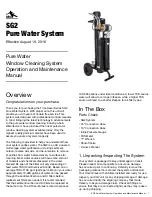
CAUTION!
Warning of leaks
Feed chemical, which remains in the overflow line at the
relief valve or bleeder valve, can attack the valve or
cause it to leak
–
Route the overflow line with a continuous slope and
moreover with the hose nozzle pointed downwards -
see .
If the overflow line is fed into the suction line, the bleed
function is blocked.
Therefore lead the overflow line back into the storage
tank.
When operating the integral relief valve close to the
opening pressure, a minimal overflow into the overflow
line can occur.
CAUTION!
Danger resulting from unnoticed diaphragm rupture
If the pump has been ordered with an electric diaphragm
rupture sensor, it still has to be installed.
–
Screw the enclosed diaphragm rupture sensor into
the liquid end.
CAUTION!
Warning of unnoticed diaphragm rupture
Only above approximately 2 bar system back pressure is
a signal generated in the event of the rupture of a dia‐
phragm.
–
Only rely on the diaphragm rupture sensor with back
pressures of greater than 2 bar.
Or install a back pressure valve and set it to a min‐
imum of 2 bar – if the installation permits this.
7.1.1 Basic installation notes
CAUTION!
Danger resulting from rupturing hydraulic components
Hydraulic components can rupture if the maximum per‐
missible operating pressure is exceeded.
–
Never allow the metering pump to run against a
closed shut-off device.
–
With metering pumps without integral relief valve:
Install a relief valve in the discharge line.
P_SI_0023
Fig. 21: Permissible alignment of the relief
valve
Diaphragm rupture sensor
Safety notes
Installation
30
Summary of Contents for S3Cb
Page 107: ...PTFE FDA No 21 CFR 177 1550 PVDF FDA No 21 CFR 177 2510 Wear parts for S3Cb 107 ...
Page 121: ...121 ...
Page 122: ...122 ...
Page 123: ...123 ...
















































